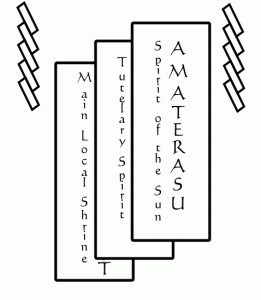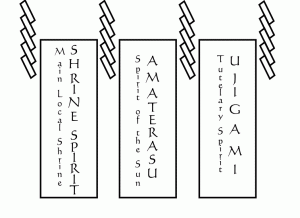The ofuda is the equivalent in the house of ‘the spirit body’ (goshintai) in the Shinto shrine. The word literally means an honourable tag or tablet, and it is usually purchased from a shrine. It acts as a symbol of the kami, and can be understood as containing the same essence. Placing an ofuda in the household altar (kamidana) is thus to welcome a spirit into the home. It’s as if it were a candle alight with the same energy as that in a Shinto shrine.
The ofuda consists of a piece of wood or a card upon which is written the name of the kami, or sometimes the name of the shrine. A ritual is performed which charges the ofuda with the power of the kami. It is as if something of the divine is transferred into it. In this sense the ofuda is sacred and should be treated with care. On no account should it be removed from the paper covering in which it is wrapped. Like a battery, it only has limited power and needs to be replaced each year.

The Association of Shinto Shrines recommends that three ofuda be placed in a household altar. These include one from Ise Jingu where Amaterasu is enshrined; one from a regional shrine that the worshipper frequents; and one from the ancestral shrine (ujigami) to which the family is attached. In the case of a single-doored kamidana, the ofuda are placed in the following order: that of Amaterasu goes on top, that of the ancestral shrine in the middle, and that of the local shrine at the back. If the household altar has three separate doors, however, then the ofuda of Amaterasu should occupy the centre, that of the ancestral shrine the right, and that of the regional shrine the left.

Adherence to the above is not common in practice, and many Japanese simply use ofuda from their favourite shrines. These are changed annually, usually around New Year when they are taken to the shrine where they were purchased and ceremonially burnt. In their place new ofuda are purchased and put in the kamidana (or simply attached to a wall). Those who do not live within reach of a shrine should make sure to replace their symbolic ofuda with a new one. For those who live abroad, it may be possible to obtain them through the post (those in the US may apply to http://www.tsubakishrine.org/). Where this is not a viable option, consideration could be given to creating one’s own.
(The above was written in conjunction with Timothy Takemoto of the Shinto Online Association, who provided the visuals. See http://nihonbunka.com/)

John, thank you for the continuous stream of information, which is always well written and deserves many readers.
May I recommend a correction for the title (Ofuda – Talisman)?
Ofuda is different from Omamori. Although Omamori is a kind of amulet, Ofuda definitely not.
In Yamakage Motohisa’s book Essence of Shinto, I wrote the following definition in the section Additional terms:
“OFUDA: Card, made of paper or wood, carefully wrapped in white paper, with the name of some Kami written on it. This card functions as the “divided spirit” of the Kami of some shrine.”
Instead of being an amulet, a short description for Ofuda could be something like:
” a shintoshrine in a nutshell ”
This better matches the contents of your article, too. The Ofuda is sacred and should be treated with care: everyday you must clean kamidana and dedicate food-offerings, together with your words of gratitude – for the sustaining energy from nature. Green shinto needs a gardener as well.
In his book Grandmaster Yamakage strongly advises against the collection of too many Ofuda. It is better to have one from your favorite shrine.
For Japanese Shinto the options to obtain an ofuda by post, or to create one’s own, seem rather strange. In Green Shinto it might be possible to create one’s own, if – and only if – one is as green and pure as kami. Ofuda is a division of kami and not an artificial symbol.
Of course, when more people outside Japan feel a real need to have an Ofuda in their daily life, we have to solve a logistic problem. The Holland Yamakage Shinto Shrine in Amsterdam is willing to help people in Europe.
All the best.
Paul, thanks for the comment. Your point about ‘talisman’ is well taken. It’s the nearest equivalent in English, I think, but if people read the article they will understand that in reality it’s more like the description you give above.
By a strange coincidence I happened to be going through the Kamigamo Shrine Kenkyukai
report about you just as your message arrived. Synchronicity or what? The report mentions that you have no ofuda, ema or ‘arrows’ at your shrine as you prefer to emphasise ‘spiritual exercises’. The report lists sixteen in all. That’s fascinating. If you’re willing, I’d love to do a feature about them on Green Shinto.
Regards
JD
um…I have a question, how are the paper ofuda attached to walls?…
is it just glue?
I heard it was rice that was used…but how does that work..do we smush it on the back?
I have a question, my wooden ofuda is too large and I can make it pass through the doors of the kamidana. I guess forcing into it it’s not very respectful, nor is filing its edges… Any ideas?
Thank You,
Nick
Good day… I would say that either of the options you mention would be unacceptable for what is regarded as a spirit-body and to be handled with extreme respect. Perhaps you could simply prop it up on the outside of the kamidana?
I did remove the whole frontal side of my Kamidana to place the Ofuda as it does not fit through the doors. The Kamidana is build to allow this.
As far as I learned it the Ofuda should be replaced every year and the old one given back to the shrine it came from. How do I do the change in the Kamidana?
Thanks for your help.
Good day, Tomio, and thank you for your enquiry, though I’m not sure what you’re asking exactly… if you mean the actual process of taking out the ofuda from the kamidana, then common sense suggests proper respect and purity in terms of washing hands beforehand and bowing etc before removing the ofuda with both hands.
Thanks so much for you answer. Is there any other rule? My new Inari ofuda is from another Shrine then the original one? What do I do with the old one? Returning would only be possible through mail. The ofuda is a bit older than a year now.
Again I’m not a priest and unable to answer with authority, but returning by mail would surely be fine as the shrine would be able to add your ofuda to its ceremonial disposal of used items. Alternatively you could construct your own ritual and offer it up with gratitude for the service it has done.
You mean burn it myself? I will think about it. Thanks so much for your quick answers.
My local shrine(南米神宮) only sells Ofuda for “home safety” or 家內安全. While the shrine’s website says to put it near the home’s front door, the online store from where I got it says it’s for Kamidana! I bought it with the intention to enshrine it in Kamidana. Is there any problem with this? Can it work just as a normal Ofuda that is not addressed to a specific issue?
I think either place would be appropriate..